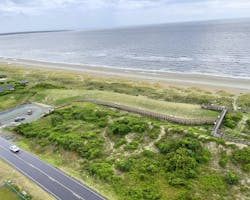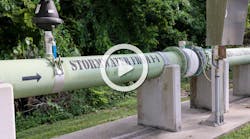Addressing Increasing Coastal Flooding with Dune Infiltration
About the author:
Marc Horstman, PE, PH, CFM is a project manager with WK Dickson’s storm water group with an emphasis on municipal storm water infrastructure, including planning and design, hydraulic and hydrologic modeling, innovative and sustainable site design, and storm water SCM design.
Most of the time, when a road floods, it's just a minor inconvenience leading people to find another way around the flooded area. However, when the road is a primary thoroughfare, it can become a significant issue that can disrupt critical access and cause a potential safety hazard. Over the past few decades, portions of Caswell Beach Road in Caswell Beach, North Carolina, had become impassible to passenger vehicles after moderate rainfall events, and it was not unusual for the road to remain impassable for more than eight hours. The road is the only ingress/egress for approximately 240 residents, the Duke Energy Progress Nuclear Pumping Station, the United States Coast Guard Station on Oak Island and the North Carolina Baptist Assembly grounds at Fort Caswell. A solution for this hazardous flooding issue was needed to allow safe passage and adequate response to emergencies during and immediately after storms.
To aid the town of Caswell Beach in solving this flooding and access problem, WK Dickson evaluated the feasibility of implementing a new and innovative system known as a Dune Infiltration System (DIS). Originally developed in 2005 as a pilot project for the Town of Kure Beach through a partnership between the Town of Kure Beach, the North Carolina Department of Transportation, and the North Carolina State University Biological & Agricultural Engineering Department, this application was initially applied to address water quality issues.
However, the uniqueness of the Caswell Beach project was its use in addressing localized flooding and public safety beyond its initial application as a water quality practice. For Caswell Beach, the new system allows the town to collect and pump water out of low-lying areas along Caswell Beach Road through storm water piping into a series of infiltration chambers embedded within the dunes that utilize the existing beach sand as infiltration media. The DIS system was optimized to reduce street flooding to a level safe for vehicular traffic within two to four hours following storm events. The DIS at Caswell Beach is only the second location in North Carolina to put a DIS into action.
The initial concept involved pumping floodwaters from four critical flooding areas to four local DISs. A conceptual design report identified potential system locations and routes for storm water pipe alignments, dune infiltration system suitability and layout, required easements, required permitting, and planning level construction cost estimates. This conceptual analysis determined several design constraints that narrowed the four potential sites to one ideal location on town-owned property near a highly visible public beach access point.
In addition to providing water quantity benefits, a DIS provides secondary water quality improvements. When it rains, water flows across impervious surfaces and picks up pollutants. Elevated bacterial levels in these pollutants can lead to beach closings or swimming advisories, impacting the local tourism-based economy. Additionally, if these elevated bacterial levels are not addressed, they can degrade the beaches' natural setting, destroy wildlife and endanger public health. However, a DIS uses the sand's natural filtering ability to remove rainfall runoff pollutants. After the runoff is diverted into the DIS, the storm water infiltrates into the sand and strips the pollutants and pathogens using natural sorption and bacterial desiccation. The filtered groundwater then migrates to the ocean flowing underneath the dunes and beach sand. Studies show these systems remove between 75% and 95% of pollutants, including pathogens, hydrocarbons, and excess nutrients.
Once design and permitting were approved, the project was bid, and construction began in January 2021. The exact timing of construction was an essential component of this project. For coastal towns, keeping the beaches open during the summer months is critical for economic vitality. Caswell Beach is a thriving vacation destination, so construction needed to be complete before the tourists arrived for the summer. Additionally, construction was timed as not to impact the area's sea turtles during their annual nesting season.
Construction entailed installing polypropylene open-bottom chambers buried beneath the dune, which collect diverted runoff. As this runoff is pumped into the chambers, the water spreads out into a bed of gravel and sand, which filters the runoff before it reaches groundwater. When the runoff is 75 feet down shore, bacteria levels are similar to that found in normal groundwater.
The complexity of this project involved both engineering and non-engineering issues. From an engineering standpoint, site suitability was a primary focus. The ideal site for the DIS has an elevated dune system (typically a site with a primary and secondary dune area) with a seasonal high-water table several feet below the surface. It was important to size the system accurately and ensure the groundwater mounding would not impact adjacent properties. For this project, comprehensive groundwater modeling was performed to ensure that the groundwater mounding underneath the DIS would not affect any adjacent private structures, including building foundations or seepage back onto the road.
Depending on the allowable elevation of the proposed DIS, the storm water runoff can either drain via gravity or be pumped into the DIS chambers. For the Caswell Beach site, the elevation difference between the road's low-lying areas and the proposed chamber required the use of a pump. The town invested in a trailer-mounted pump attached to the fire truck, and special pump ports were installed at the low points. This setup allows the town to target specific low points as needed to ensure a quick response in addressing the flooding issues.
From an environmental standpoint, this project had to be coordinated with the North Carolina Division of Coastal Management to get approval to construct in the secondary dune system, as overall impacts to the dune systems should be minimized. After multiple meetings discussing the benefits provided by the proposed DIS, the submitted request was approved. The permitting request involved a variance to their permit to show the system was the only option to solve the flooding issues and that this project was crucial to protecting public health and safety.
For future projects, easements will most likely need to be acquired for construction and maintenance access. This process can prove to be challenging for oceanfront property. Fortunately, the final site chosen out of the four areas studied happened to be on property the town already owned.
While the original Kure Beach DIS was designed to address water quality (specifically pathogen pollution to prevent beach closures), the Caswell Beach DIS project applied the same concept to address the dangers associated with road flooding. The DIS does double duty; it can be implemented within beachfront communities to address road flooding issues while also providing a water quality benefit. Another significant advantage of these systems is that they can utilize oceanfront property's primary and secondary dune systems that will never be developed, assuming clear access to the site.
Overall, the completion of this DIS project resulted in several important benefits:
- Flooding. The project addresses flooding on the only access road. Emergency vehicles and first responders will reach people quicker after storm events, and the road will become passable sooner than previously.
- Water Quality. By taking storm water runoff and infiltrating it back into the ground, the project results in a water quality benefit by reducing runoff from the road, stripping pollutants out of the runoff and contributing to the area's groundwater recharge. For beach communities dealing with beach closures due to contaminated storm water from a direct discharge system, a DIS can reduce or eliminate their ocean outfalls and keep their beaches clean and open to the public.
- Educational. The proximity of the DIS to a highly visible public beach access provides educational opportunities for visitors and residents to learn about the benefits of infiltration systems and storm water improvements.
Coastal flooding is more than a mere nuisance; it can be a significant safety hazard to these communities. DISs are a low-cost, low-impact solution for diminishing storm water discharge and reducing bacteria loads to recreational beaches.
"Being prepared for flooding and the safety of our citizens is a primary concern for the town,” the Mayor of Caswell Beach Deborah Ahlers said. “The recently completed dune infiltration system will help in this regard and provide a water quality benefit – a vital component for coastal communities like Caswell Beach. With this project being only the second one of its kind in the state, we are proud to lead the way in how our neighboring communities can deal with increasing coastal flooding."


